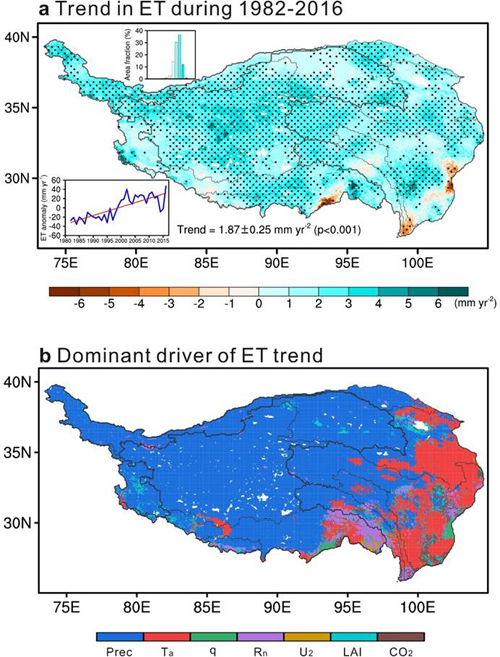New Study Reveals Evapotranspiration Magnitude, Its Trend and Key Drivers over Tibetan Plateau from 1982-2016
Evapotranspiration (ET) is a key component in the energy and water cycles. On a global scale, about two thirds of land precipitation returns to atmosphere via ET. The Tibetan Plateau (TP), dubbed as the “Asian Water Tower”, is the source of tens of major rivers in Asia. ET is a key variable that determines not only water storage in the “Asian Water Tower” but also the water availability for downstream population. However, it remains poorly understood that how much water evaporates from TP and how key drivers dominate long-term ET trend because of limited ET observations.
A new study published in Agricultural and Forest Meteorology by a research group at the Institute of Geographic Sciences and Natural Resources Research, Chinese Academy of Sciences thoroughly addressed three critical issues: ET magnitude, its trend and key drivers over TP from 1982-2016.
“Thanks to the recent advances in eddy-covariance flux observations in such a harsh region, which provide key data to constrain models for a more accurate ET estimation on the Tibetan Plateau” says Dr. MA Ning, the lead author of this study. “The model we used, PML_V2, is a state-of-the-art diagnostic remote sensing ET model and, thus, has a great advantage in estimating ET in such a data-scarce region.”
The study found that TP-averaged annual ET is 353 mm yr-1, suggesting that the water loss via evapotranspiration from TP land surface is roughly 920 gigaton when assuming a regional area of 2.6×106 km2, an amount close to the annual flow volume of the Yangtze River.
The authors reported that ET in TP increased significantly at a rate of 1.87 mm yr-2 during 1982-2016. “This indicates that the hydrological cycle is accelerating across TP under a warming climate in the past few decades,” adds MA Ning.
“Such a strong increase in ET is due mainly to precipitation, which is especially apparent since the late-1990s.” explains Prof. ZHANG Yongqiang, the corresponding author of this study. “We found that precipitation is the dominant driver that affects ET trend in most parts of TP except certain regions in the southeastern and eastern TP, where net radiation and air temperature do so instead, respectively.”
“There is still an urgent need of elucidating the consequence of varying ET on the water resources in this special region,” adds ZHANG Yongqiang. “Our group is now coupling the PML_V2 into hydrological models to facilitate runoff simulations in a changing climate.”
(a) The spatial pattern of trends in ET during 1982-2016 and (b) The dominant driver of ET trend across the Tibetan Plateau

Read Full Article here: https://doi.org/10.1016/j.agrformet.2022.108887
Download this ET product here: https://doi.org/10.12072/ncdc.Eco-Hydro.db1676.2022
Download attachments: